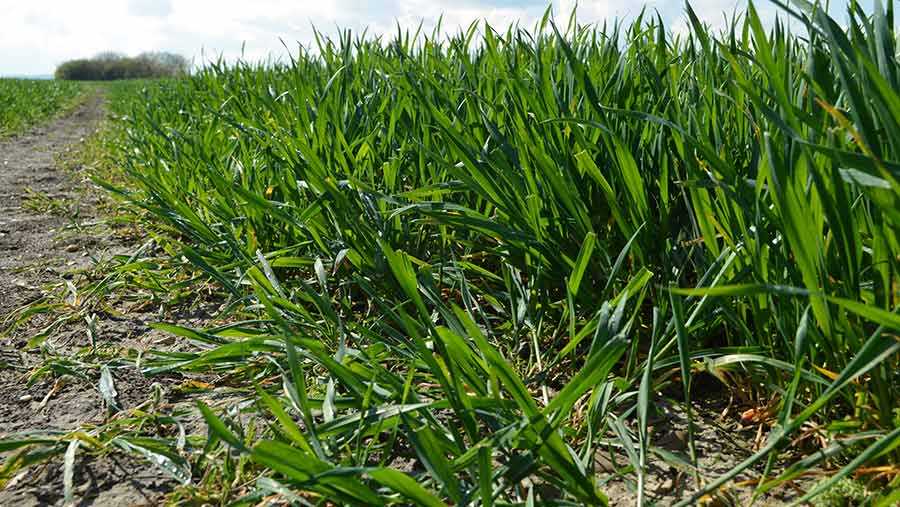Oxford grower cuts costs with a two-spray wheat fungicide strategy
 Mark Oldroyd, left, with Jack Bedlow
Mark Oldroyd, left, with Jack Bedlow Mark Oldroyd is looking to cut his wheat fungicide costs by moving to a two-spray programme using a variety with good disease resistance allied with delayed drilling in the autumn.
Growing the winter wheat variety Graham on the south Oxfordshire farm he manages, Mr Oldroyd has already missed out an early T0 spray and hope this season’s fungicide bill will be as low as £80/ha.
With some key fungicides set to be banned, he is looking to use his agrochemical armoury wisely in conjunction with new wheat varieties offering improved disease resistance.
“We are looking to use varieties to save money on fungicides and with a two-spray programme we can aim at spending about £80/ha,” he tells Farmers Weekly.
See also: How to save up to £50/ha on your wheat fungicide programme
Farm facts
MES Dart & Partners & AG Hedges Farms Ltd, Sherwood Farm, Brightwell-cum-Sotwell, Oxfordshire
- 1,450ha, consisting of 1,000ha of combinable crops, 300ha of grassland and 150ha of maize
- Soils: Light gravel to heavy Oxford clays
- Arable rotation: Winter wheat, maize, winter wheat, winter or spring barley, then a break crop of oilseed rape or winter beans
- Grassland rotation: Three years of grass leys, winter wheat, winter/spring barley, oilseed rape.
Drilling dates
A few years ago wheat drilling dates were pulled back by some four weeks to get on top of troublesome blackgrass, and this has had the added benefit of reducing disease risk.
Most of the wheat is now drilled between 1-18 October with the aim to finish by the end of October, as the autumn can be busy with 150ha of maize to cut and slurry from 650 dairy cows to spread.
The farm grows nearly 300ha of winter wheat equally divided between the milling variety Skyfall, biscuit maker Barrel and the feed variety Graham.
“Graham is an ideal variety for October drilling and last year yielded towards 11t/ha,” Mr Oldroyd says.
Septoria is the main disease worry on the farm in the Thames Valley, just downstream from Oxford, and the varieties neatly divide between Graham with good resistance to septoria, moderately resistant Skyfall and Barrel being fairly susceptible.
T0 fungicide
The Skyfall and Barrel have had an early T0 spray this season but the Graham missed out, and although there was septoria on the lower leaves of Graham the crop looked very healthy in early April.
The T0 of choice was the two azoles plus the multisite chlorothalonil product Cherokee, which is in a 12-month use-up period to the end of 2019 after the fungicide was banned by the European Union for failing a toxicity test.
In addition, straight chlorothalonil is set to be banned with a use-up period still to be set, but its use is likely to be allowed into the early summer of 2020.
Mr Oldroyd manages nearly 1,500ha of land at Sherwood Farm, Brightwell-cum-Sotwell, Wallingford, Oxfordshire along with assistant manager Jack Bedlow, and with no rain on the farm in the past two weeks of March, disease levels were generally low in early April.
Skyfall and Barrel
The early T0 spray went on the Skyfall and Barrel in the first few days of April, and with the crops racing away in the early spring he expects them to reach the next critical T1 stage in mid- to late April.
With no T0 on the Graham, Mr Oldroyd is not expecting to cut back on his fungicide spray programme at T1, and is planning a full SDHI-azole-chorothalonil approach.
The same programme will be followed for Barrel, but he is hoping to have some flexibility for the Skyfall, which might have a reduced rate SHDI at T1 as the variety has moderate resistance to septoria and did have a T0 spray.
The same approach is planned for the important T2 flag leaf spray with an SDHI-azole-chlorothalonil combination pencilled in for all three varieties.
Head spray
Last year, the dry summer prompted him to miss out the T3 head spray for the Graham and this will be followed again this year, while the other two varieties are likely to see a two-azole mix of prothioconazole + tebuconazole for the ear spray.
“Last year the lesson we learned was that with the right variety we can cut back on fungicide costs,” he says.
The likely £80/ha fungicide cost this season compares with a range of £80-120/ha spent over the past few years on the farm.
Fungicide strategy
Iain Hamilton, senior field technical manager at the agrochemicals and seeds group Syngenta, which bred Graham, says wheat growers can save £20-25/ha on fungicides by using his group’s co-called Adaptive Disease Management (ADM) strategy.
This works by adapting fungicide use by variety, drilling date, location and season. Growers can influence the first two and should be very aware of the effects of the last two, he adds.

Mr Hamilton points out that the brown rust-susceptible variety Crusoe is likely to see the disease in the brown rust hot spot of Kent, but in wetter Shropshire septoria will be the main disease worry.
Similarly, with the yellow rust-susceptible variety Reflection the disease will be seen in the dry conditions of Suffolk but over in the wetter west of Herefordshire septoria is again the key disease threat.
If varieties with good resistance to septoria are chosen, such as Syngenta’s Graham and those with even better septoria resistance scores such as Sundance and Extase, and drilled late in the autumn then lower fungicide costs can be achieved.
Less spend
The group compared comprehensive fungicides programmes with those based on ADM, and this latter strategy was the most cost effective as it produced the same yield for less spend.
“Over 12 sites, it was difficult to split the programmes in terms of yield but adapting to variety and location certainly works for spending less,” Mr Hamilton says.
Using the ADM strategy, possible savings could come from omitting a T0 and using a low cost T1 such as an azole-strobilurin-chlorothalonil mix or a reduce rate of an SDHI mix formulation.
Low-risk varieties where the savings can be made include Graham, Zyatt, Sundance, Dunston, Costello and Gleam, and these varieties currently account for 40% of certified wheat seed sales.
Winter wheat disease resistance scores – current AHDB Recommended List |
|||
| Variety | Septoria | Yellow rust | Brown rust |
| Graham | 6.9 | 8 | 6 |
| Skyfall | 5.9 | 5 | 8 |
| Basset | 5.1 | 8 | 5 |
| Crusoe | 6.5 | 9 | 3 |
| Zyatt | 6.4 | 8 | 6 |
| Dunston | 6.7 | 7 | 6 |
| Sundance | 7.9 | 9 | 6 |
| Extase | 8.1 | 9 | 7 |
| Scale of 1-9, where 1 is very susceptible and 9 shows good resistance | |||

